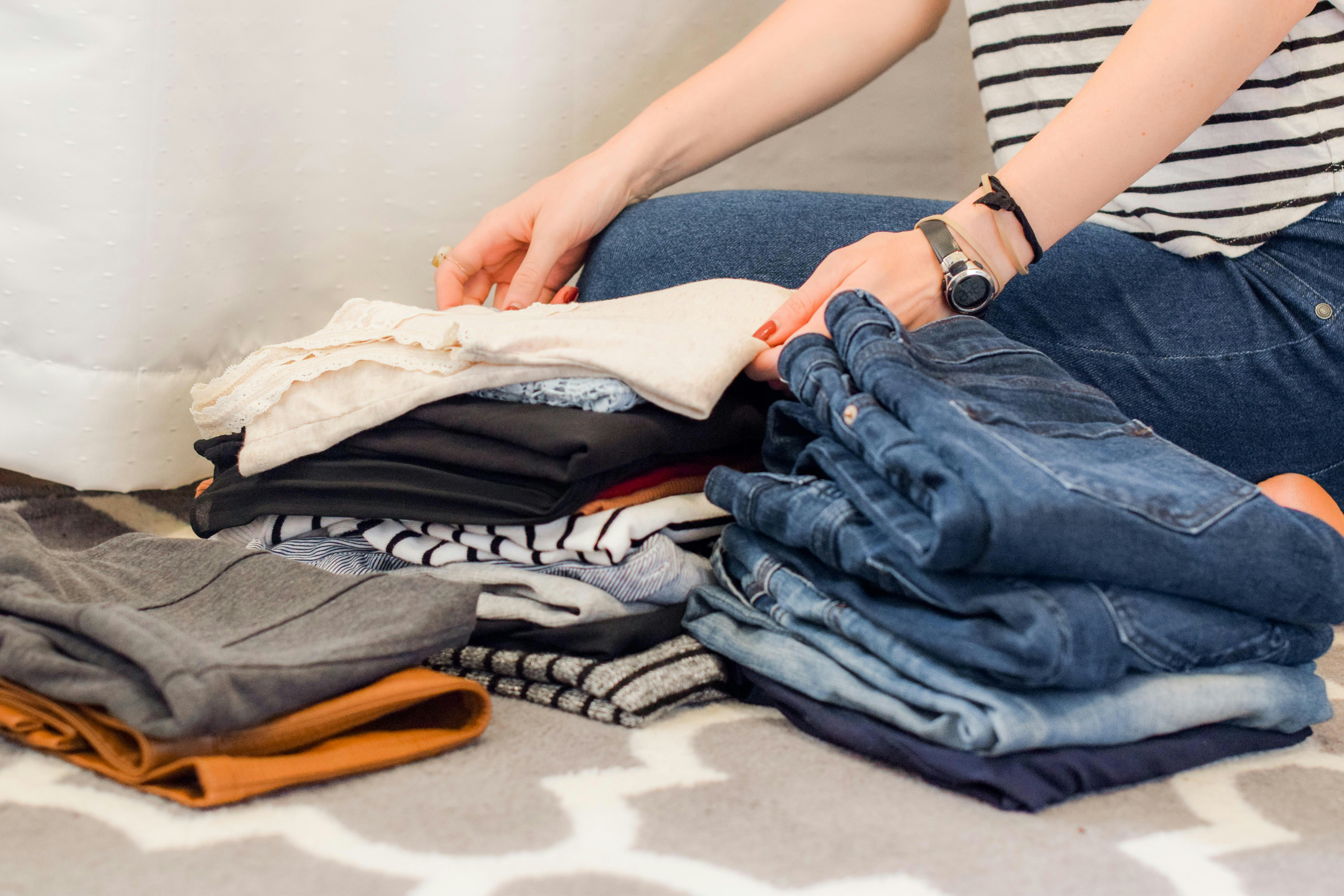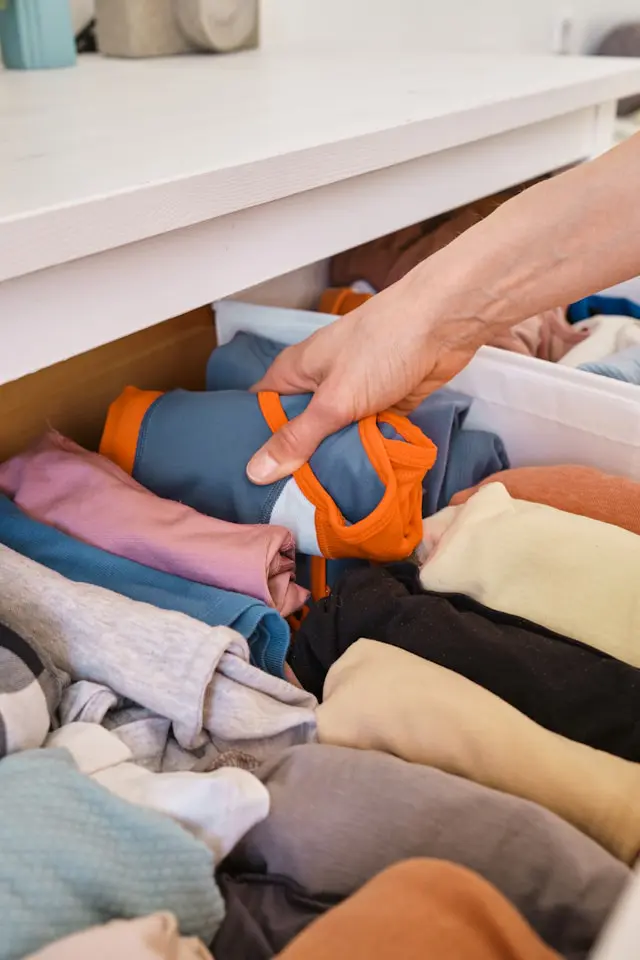Decluttering Tips at a Glance
- Start Small & Consistent: Tackle micro-zones for 10 minutes a day to avoid overwhelm and build momentum.
- Use the Four-Box Method: Label bins or boxes Keep, Donate, Trash, and Relocate to make decisions fast and keep clutter moving forward.
- Prioritize High-Impact Areas: Focus first on spaces that affect daily life (entryway, kitchen counters, closet) to experience immediate relief.
- Adopt “One In, One Out”: For every new item you bring home, let go of an existing one. This prevents clutter from creeping back.
- Celebrate Small Wins: Acknowledge each cleared drawer or shelf. Positive reinforcement keeps you motivated.
Did you know that a cluttered home can negatively impact your mental health and productivity? Studies show that 54% of Americans feel overwhelmed by clutter. The good news? You don’t need to spend an entire week or hire a professional organizer to take back your space. With these 9 easy decluttering tips, you can simplify your home, streamline your routines, and create a calm, refreshing environment that feels like a true sanctuary.

Why You Should Declutter Your Home
Decluttering isn’t just about making your space look nice; it’s about improving your life. Here’s why it matters:
- Reduces stress: A UCLA study found that individuals who describe their homes as cluttered were more likely to experience higher levels of cortisol, a stress hormone. A tidy space sends a signal to your brain that everything is under control.
- Boosts productivity: Physical clutter in your surroundings competes for your attention, resulting in decreased performance and increased stress. Fewer distractions mean you can tackle more tasks—like paying bills, cooking dinner, or helping kids with homework.
- Saves time and money: Ever bought a new spatula because you couldn’t find the one you already own? Decluttering helps you locate what you need, so you stop wasting money on duplicates. Plus, cleaning a tidy home takes less time.
- Creates room to breathe: A clutter-free space feels open and inviting. Physically, you’ll have more room to move. Mentally, you’ll feel lighter, like you’ve lifted a weight off your shoulders.
1. Start Small and Build Momentum
Jumping into a huge decluttering project can feel overwhelming, especially if your home is packed with stuff. Instead, start with a tiny, manageable area to build confidence and momentum.
Choose a “Micro Zone”
Pick one small spot—like a single drawer, a corner of your kitchen counter, or the top of your nightstand. For example, if your bathroom vanity is cluttered with half-used lotion bottles and stray hair ties, focus there first. By starting small, you avoid feeling paralyzed by the bigger mess.
Work in 5- or 10-Minute Bursts
Set a timer on your phone for just 5 or 10 minutes. You’ll be amazed at how much you can accomplish in a short sprint. For instance, in 10 minutes, you could clear out a junk drawer filled with old batteries, random pens, and expired coupons. Short sessions make decluttering feel doable, even on busy days.
Celebrate Quick Wins
After you finish, take a moment to admire your work. Snap a quick before-and-after photo of that newly organized nightstand or drawer. Seeing the difference fuels your motivation to keep going.
2. Apply the Four-Box Method
One of the best decluttering tips is the Four-Box Method. It’s simple, fast, and forces you to make decisions without overthinking. Grab four boxes, bins, or even laundry baskets and label them:
- Keep: For items you use regularly or truly love.
- Donate/Sell: For things in good condition that someone else could use.
- Trash/Recycle: For broken, outdated, or useless items.
- Relocate: For items that belong in another room or area.
How to Use It
Pick a small area, like a bookshelf or a closet shelf. Pick up each item and decide which box it belongs in. For example, if you find an old phone charger that doesn’t fit any of your current devices, toss it in the Trash/Recycle box. If you find a book you loved but won’t reread, put it in Donate/Sell. Don’t pause to reminisce or second guess—if you hesitate, default to Donate/Sell. This method keeps you moving and prevents decision fatigue. Once you’re done, immediately move the Relocate items to their proper spots, take out the trash, and set the donation box by the door.
3. Ask Three Key Questions
To make tough choices easier, ask yourself three questions about each item:
- Do I need this? Is it essential for daily life, like a favorite kitchen knife or your winter coat?
- Do I use it? Have you used it in the last year, or is it just taking up space?
- Do I love it? Does it spark joy or hold deep sentimental value?
Hanger Experiment
If the answer to any question is “no,” consider letting it go. For clothes, try the hanger experiment: turn all your hangers backward in your closet. After you wear an item, hang it back the right way. After six months, donate anything still hanging backward—you clearly don’t wear it. This trick is a game-changer for decluttering wardrobes without the guesswork.
4. Organize What You Keep
Once you’ve decluttered, organize the items you’re keeping so they’re easy to find and use. Smart storage is one of the most effective decluttering tips for maintaining order.
Use Clear Storage
Invest in transparent bins or containers so you can see what’s inside without digging. For example, store craft supplies or holiday decorations in clear plastic bins. Label everything—shelves, drawers, and bins—with simple tags like “Baking Tools” or “Winter Gear.”
Group Like with Like
Keep similar items together to avoid duplicates and make things easy to find. For instance, store all baking supplies (measuring cups, mixing bowls) in one kitchen cabinet. Group office supplies like pens and notebooks in a single desk drawer. This “zoning” approach keeps your home functional and organized.
Use Vertical and Hidden Space
Maximize your space by thinking vertically. Install wall hooks for bags, hats, or keys to free up floor space. Use over-door racks for shoes, cleaning supplies, or pantry items. For bulky items like extra blankets or off-season clothes, try under-bed storage bins or vacuum-seal bags to keep them out of sight but accessible.

5. Let Go (Donate, Sell, or Trash)
Getting rid of clutter is just as important as organizing what you keep. Here’s how to handle the items you’re not keeping:
- Donate Immediately: Keep a donation bag or box in your entryway or car trunk. When it’s full, drop it off at a local charity or thrift store. For example, donate old towels to an animal shelter or books to a library sale.
- Sell Selectively: For valuable items like electronics, furniture, or designer clothes, try selling on apps like eBay, Poshmark, or Facebook Marketplace.
- Recycle Responsibly: Don’t just toss electronics, batteries, or old paint cans in the trash. Check with your local recycling center or landfill. Many offer free drop-off for hazardous items, ensuring you declutter without harming the environment.
6. Tackle the Tough Spots
Some areas are harder to declutter because of emotional ties or sheer volume. Here’s how to handle them:
Sentimental Items
Old photos, gifts, or childhood mementos can tug at your heartstrings. Limit keepsakes to one small memory box per person or year. For items you love but can’t keep, take a photo and store it digitally. Flash drives are cheap and small.
Paper Clutter
Paper piles up fast—bills, school forms, junk mail. Switch to digital statements for bills and subscriptions to cut down on paper. Scan important documents and keep a small folder for must-have papers, like passports or birth certificates.
Kid and Pet Stuff
Kids’ toys and pet gear can take over your home. Rotate toys by keeping a small set out and storing the rest in bins. Swap them every few weeks to keep things fresh. For pets, store leashes, toys, and grooming tools in one labeled bin. Toss chewed-up toys or frayed collars to keep things manageable.
7. Adopt the “One In, One Out” Rule
To prevent clutter from creeping back, follow the “One In, One Out” rule. For every new item you bring home—a pair of jeans, a kitchen gadget, or a new book—remove one similar item. For example, if you buy a new coffee mug, donate an old one you rarely use. This habit keeps your stuff in check and makes you think twice before buying impulsively.
8. Enlist Support and Make It Fun
Decluttering doesn’t have to be a solo chore. Turn it into a fun, social activity:
- Buddy System: Invite a friend or family member to help. They can offer a fresh perspective and make tough decisions easier. For example, your best friend might point out that you don’t need three identical black sweaters.
- Play Music or Podcasts: Crank up your favorite playlist or listen to a funny podcast to keep your energy high. Upbeat tunes make sorting through a pile of clothes feel like less of a slog.
- Set Mini-Challenges: If you’re decluttering with others, make it a game. Challenge everyone to find 10 items to donate in 10 minutes. The winner gets bragging rights or a prize.
9. Maintain Your Sanctuary
A clutter-free home needs regular care to stay that way. Build these habits to keep your space serene:
- Daily Reset: Spend 5 minutes each morning making your bed and clearing surfaces. Put away dishes, fold blankets, and toss stray papers. This quick routine sets a calm tone for the day.
- Weekly Review: On weekends, spend 20 minutes reviewing your calendar, purging old to-do lists, and clearing your email inbox. This keeps both your home and mind organized.
- Seasonal Audit: Every three months, check closets, kitchen cabinets, and storage bins. Consider donating or recycling anything you haven’t used since the last audit. For example, if you didn’t wear that heavy scarf all winter, it may be time to let it go.

Keep the Momentum Going
Decluttering your home doesn’t have to feel like climbing a mountain. By starting small, making quick decisions, and building simple habits, you can turn chaos into calm—one drawer, one shelf, one corner at a time. These decluttering tips not only create a neater space but also reduce stress, sharpen your focus, and give you more time for the things you love. Ready to take control of your home?
More from Bananomad
- Discover the key advantages of skipping TV, including gaining more time, lowering stress levels, and enhancing your overall well-being.
- Find out how dead hangs enhance grip strength, improve posture, and alleviate back pain. Begin with our simple guide today.
- Uncover 20 smart travel trailer storage solutions, covering interior organization and exterior options. Expert advice for optimizing space in your RV.


Leave a Reply